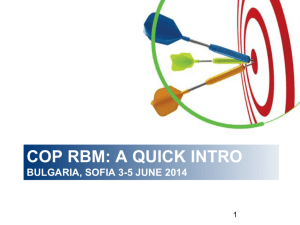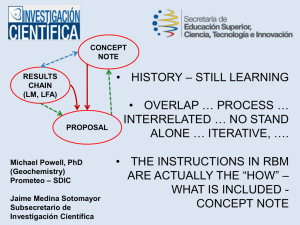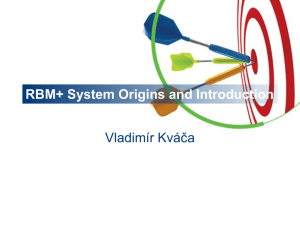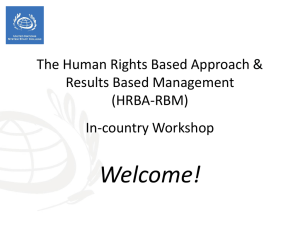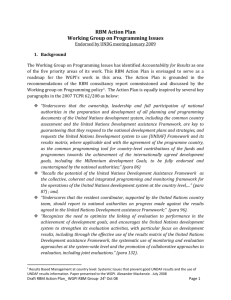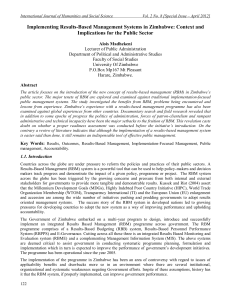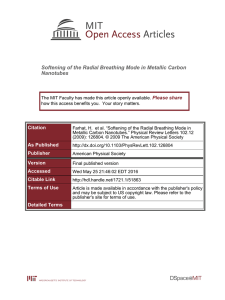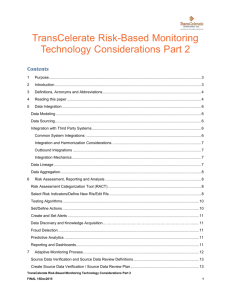Enhancing synergies between Policy Makers and
advertisement
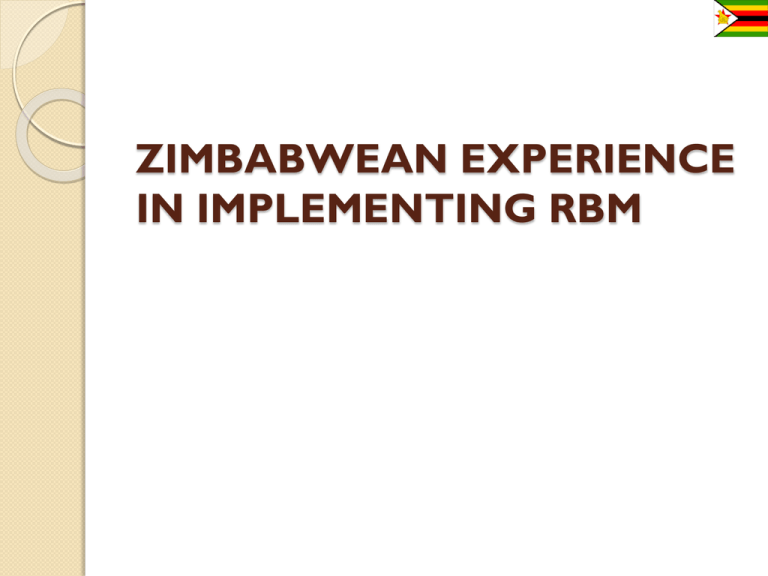
ZIMBABWEAN EXPERIENCE IN IMPLEMENTING RBM ZIMBABWE •Population:12 521 000 people (2009 estimates) •Area 150,871 sq miles (390,757 sq km). •Abundant natural resources •Preferred tourist destination •World source of skilled human capital •Highest literacy rate in Africa – 92% (2010) • Public services provided by central government, state enterprises and parastatals and local authorities • Over 200 000 members of the public service •Facing social-political-economic challenges and needs administrative transformation due to poor service delivery 2 RESULTS BASED MANAGEMENT(RBM) DEFINED It is a contemporary strategic management approach meant to timely achieve desired results with available resources. It is characterised by: - linking results to resources - regular monitoring and evaluation - high degree of accountability Components of RBM 1. Integrated Development Planning(IDP) A coordinated top down planning approach that outlines national, sectoral, ministerial and departmental vision, key result areas, goals, objectives, outputs, outcomes and impact (inter-linkages). 2. Results Based Budgeting(RBB) A budgetary approach that shows a relationship between expenditure and targets.(i.e links resources to results). 3. Results Based Personnel Performance System(RBPPS) A human performance management tool that focuses on systematic and purposive usage of human resources to achieve desired results using availed resources. Components continued Results Based Monitoring and Evaluation and Management Information System (RBM&E/MIS) A time framed assessment and performance reporting system backed by a comprehensive management information system. 5. E-government An e –enabled and easily accessible framework for all government services on offer. 4. WHY WE OPTED FOR RBM Findings of the 1989 Public Service Review Commission highlighted that: • Government lacked a results oriented performance management culture. • There was an insatiable demand for quality public services. • Increasing resource constraints • Public demand for quality and more responsive services(demand for transformation) • Development partners` demand for accountability and results • The need to adopt best practices in line with globalization. • Deteriorating service delivery in terms of quantity, quality and timeliness WHY WE OPTED FOR RBM continued • • • Recommendations from the Public Service Review Commission led to the introduction of the Performance Management System in 1999. This performance management system focused more on activity completion rather than achievement of desired results. In 2005 the Government of Zimbabwe adopted Results-Based Management system that focuses more on achieving results using given expenditure targets. BENEFITS DERIVED FROM RBM Improved resource allocation and usage Coordinated approach to national development[IDP] • Improved public sector performance • Enhanced performance in terms of quality and timely service delivery of public services • Greater policy coordination • Better value for money through cost effective measures • More effective monitoring and evaluation of programmes and projects. • • LEAD AGENCIES IN IMPLEMENTATION OF RBM • • • • • • The Office of the President and Cabinet (OPC) is the overall leader and initiator of the RBM system Ministry of Economic Planning and Investment Promotion leads Integrated Development Planning (IDP). Ministry of Finance leads Results Based Budgeting(RBB) Public Service Commission as the employer leads the Personnel Performance System(PPS) ,Monitoring &Evaluation(M&E) and Human Resources Management Information System (HRMIS) Ministry of Public Service leads in capacitating implementers of RBM Ministry of Information ,Communication & Technology leads the EGovernment component. CRITICAL DOCUMENTS IN IMPLEMENTING RBM LEVEL DOCUMENT NATIONAL NATIONAL VISION, KEY RESULT AREAS, GOALS SECTOR/CLUSTER ( RIGHTS & GOVERNANCE, SOCIAL, ECONOMIC, INFRASTRUCTURE) SECTORAL VISION, KEY RESULT AREAS AND GOALS MINISTRY MINISTRY STRATEGIC PLAN, INTERGRATED PERFORMANCE AGREEMENT (MIPA), SECRETARY`S PERFORMANCE CONTRACT DEPARTMENT DEPARTMENTAL INTERGRATED PERFORMANCE AGREEMENT(DIPA) & DEPARTMENTAL WORK PERFOMANCE AND MONITORING PLAN SECTION SECTIONAL WORK, PERFORMANCE AND MONITORING PLAN UNIT UNIT WORK, PERFORMANCE AND MONITORING PLAN INDIVIDUAL INDIVIDUAL WORKPLANS i.e. SECRETARY`S PERFORMANCE CONTRACT, HEAD OF DEPARTMENT FORM, BANDS C,D,E & F FORM, BANDS A & B FORM IMPLEMENTATION PROCESS Became Government Policy in 2005 as a management tool to improve public sector management. Setting up of management committees spearheaded by the Office of the President and Cabinet. Development of critical RBM documents. Sensitisation workshops for top officials i.e. Members of Parliament and Permanent Secretaries. IMPLEMENTATION PROCESS continued Training of core trainers in RBM. Training of trainers at Public Service Training Institutes. Cascading of training to end users (on-going). Monitoring of RBM through the Performance Audit and Inspectorate Agency of the Public Service Commission (on-going). Review of the implementation by consultants which led to a reviewed RBM report. CHALLENGES IN RBM IMPLEMENTATION • • • • • • • Disconnect between the politician and technocrats (conflict between the appointed and the elected). Lack of shared understanding and perceptions of the RBM concept. Low technological uptake i.e. availability and capacity Residual resistance to change. Resource constraints such as limited human capital and financial resources. Limited coverage of training because of the large numbers involved. Dilution of training through cascading. SUCCESSES TO DATE • • • • • Creation of clients charters in all government ministries. Capacity building in RBM through training of all levels of management in Public Service, Parastatals and Local Authorities. A reviewed Government of Zimbabwe Public Service Training and Development Policy. Institutionalisation of RBM through development of training modules, RBM reference documents and training infrastructure. Implementation of e-government e.g. e-enabled RBM documents, e-passport and Ministries` websites SUCCESSES TO DATE Continued Efficient financial management through Public Financial Management System(PFMS). • Enhanced compliance to project schedules. • Shared vision of national priorities. • Buy-in across ministries, parastatals and local authorities in RBM implementation. • Improved linkages within and between clusters/sectors and Ministries • Instutionalized capacity building in Government •


